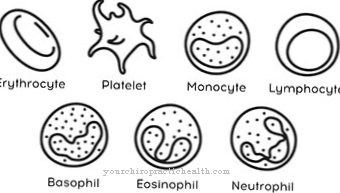The aplastic crisis refers to a drastic deterioration in the formation of red blood cells (erythrocytes) as part of haemolytic anemia. The cause of this crisis is usually the coincidence of chronic hemolytic anemia with a ringlet infection. This critical condition can only be overcome with a blood transfusion.
What is an aplastic crisis?

© achiichiii - stock.adobe.com
The aplastic crisis is a rare complication of certain viral infections. In particular, the virus, which is responsible for rubella, triggers an aplastic crisis under certain conditions. This is parvovirus B19. In addition to the viral infection, chronic haemolytic anemia is a prerequisite for this crisis.
In the context of hemolytic anemia, there is a rapid breakdown of red blood cells (hemolysis) due to various causes. The viruses ultimately responsible for triggering the aplastic crisis also prevent the formation of new blood cells from the stem cells of the bone marrow. As a result, the body is threatened with the short-term breakdown of all erythrocytes without their formation.
The critical reduction in erythrocytes is life-threatening because the oxygen supply to the organism is highly endangered. The prognosis depends on the severity of the deficiency in erythrocytes. The word "aplastic" means absent or nonexistent. The term "aplastic crisis" is derived from this and is generally characterized by the sudden reduction in red blood cells in an already existing chronic hemolytic anemia.
causes
The cause of an aplastic crisis is always an infection with viruses that directly inhibit the production of erythrocytes. Mostly it is the parvovirus B19. Another prerequisite, as already mentioned, is the presence of chronic hemolytic anemia. Parvovirus B19 causes the normally harmless red rubella infection.
Since an infection with Parvovirus B19 results in lifelong immunity, children are preferably affected because the infection rate is high in children. Then as adults they are immune. But adults who did not suffer from rubella as children can still be infected with this virus.
The virus itself infects the progenitor cells of the erythrocytes and thereby interferes with the conversion of these stem cells into mature red blood cells. An infection with parvovirus B19 is therefore associated with temporary anemia, because mature erythrocytes always die during the time in which no erythrocytes are formed. This is a normal process that happens all the time. The virus only becomes a danger in people who already suffer from chronic hemolytic anemia.
In hemolytic anemia, there is an increased breakdown of red blood cells from the outset. If both processes occur together, a dangerous shortage of erythrocytes can develop, which is often fatal. Rubella virus infection alone does not usually cause severe anemia. Before the normal breakdown of erythrocytes leads to a threatening erythrocyte deficiency, the infection is already subsiding and the production of red blood cells starts again.
Chronic hemolytic anemia can have many causes. Often these are genetically caused blood diseases such as sickle cell anemia, spheroid cell anemia, thalassemia, paroxysmal nocturnal hemoglobinuria or glucose-6-phosphate dehydrogenase deficiency (favism). But also autoimmune diseases, in which the immune system is directed against the body's own erythrocytes, can trigger hemolytic anemia.
Other causes can be drug poisoning or other rare diseases. The aplastic crisis is thus both a possible complication of the infection with parvovirus B19 and one of the chronic hemolytic anemia, which only occurs when both conditions are present at the same time.
Symptoms, ailments & signs
In general, a rubble infection is either symptom-free or shows a flu-like appearance without a rash or only a rash without further health problems. In people with chronic hemolytic anemia, the infection does not have a rash.
Instead, the symptoms of an aplastic crisis appear quickly. The patient quickly becomes pale and increasingly tired. Other symptoms are fever, headache, stomach pain, or vomiting. Without treatment, there is severe oxygen deficiency with the risk of cardiovascular collapse.
Diagnosis & course
The diagnosis of an aplastic crisis is first made on the basis of the symptoms occurring in the context of a ringlet infection. In most cases, hemolytic anemia is also known. If there is still an infection with parvovirus B19, the diagnosis of the aplastic crisis can be made as soon as the typical symptoms appear. Laboratory tests show a sharp drop in the hemoglobin concentration to 3 to 4 g / dl within a few days.
Reticulocytes are almost completely absent. These are still young, immature erythrocytes that should have just formed from their precursor cells. This absence suggests that erythrocyte formation is not taking place. Less often, the concentration of thrombocytes (blood platelets) and neutrophils (white blood cells) is decreased.
Complications
The aplastic crisis presupposes chronic hemolytic anemia and is caused by the rapid deterioration in the formation of red blood cells. The symptom is associated with a viral infection and represents an extreme situation for those affected. The aplastic crisis primarily affects children of all ages.
The symptom can also break out in adults who have no immunity, in particular against rubella. The crisis is triggered by viruses that attack the stem cells of the bone marrow directly and stop the entire formation of blood cells from there. The life-threatening condition endangers the oxygen supply to the organism. The consequences of complications are fatal and can lead to death if medical help is not taken in good time.
As a rule, the symptom is paleness, tiredness, bulging pain, vomiting and headache accompanied by a fever. The outbreak of an aplastic crisis is particularly dangerous in children with CDA. The spontaneous drop in highly concentrated red blood pigment sets in motion an immediate anemia.
Cardiovascular failure occurs. Parents who do not recognize the signs of illness or misinterpret them put the child in mortal danger. It belongs immediately to the emergency room, where a blood transfusion is initiated. The transfusion is uncomplicated and supports the weakened body in fighting the virus. CDA patients should always avoid contact with people infected with the virus.
When should you go to the doctor?
If an aplastic crisis is suspected, a doctor should be consulted immediately. If the typical symptoms (flu-like symptoms, stomach pain, fever) are noticed, a visit to a doctor is recommended for further clarification. A medical diagnosis of the underlying disease makes sense solely for reasons of the risk of infection. Therefore, if there are signs of an aplastic crisis, you should always speak to your family doctor or pediatrician.
A specific suspicion, for example if the symptoms are directly related to a viral infection, drug abuse or a long medical history, requires immediate medical clarification. If there are severe symptoms such as paleness, tiredness, severe nausea or vomiting, an ambulance must be called immediately. Infants and young children should be taken to the nearest emergency room immediately if there are signs of an aplastic crisis. This is particularly recommended if you have pre-existing diseases of the immune system or the cardiovascular system. In the event of a circulatory collapse or heart failure, first aid measures must also be taken. When the emergency services arrive, they must be informed of the possible cause.
Doctors & therapists in your area
Treatment & Therapy
The aplastic crisis is a serious emergency that requires immediate treatment to avert a life-threatening oxygen deficit. In this situation, a blood transfusion must urgently be carried out in order to avoid cardiovascular failure. With the blood transfusion, the time can be bridged until the virus is completely combated.
Outlook & forecast
The aplastic crisis is an emergency situation. Without immediate medical care, the patient threatens to die quickly. In the situation, the body has no way of helping or healing itself on its own. The longer there is no intensive care, the higher the risk of death for those affected. With fast and professional treatment, the prognostic outlook changes significantly.
In an adult without any other serious illnesses and with a fundamentally stable immune system, a full recovery is possible within a few days or weeks. However, since the crisis is usually triggered by a medical incident or illness, the underlying illness is largely responsible for the prospect of recovery. If the patient has an aplastic history, there is a high risk of death.
Even if the aplastic crisis can be overcome, complications can arise in the further course that result in the loss of life. If there is a one-off incident of red blood cell deficiency, the prognosis improves immensely. The aplastic crisis is often triggered by a virus attack. Once the offending virus can be diagnosed and treated, the patient is on the path to health improvement. Usually, recovery will be achieved within the next few weeks or months.
prevention
People with chronic hemolytic anemia are strongly advised to protect themselves from being infected with parvovirus B19 in order to avoid an anaplastic crisis.For example, children at risk should urgently avoid contact with sick children by staying at home if rubella develops in school or kindergarten. However, if contact has nevertheless taken place, it is necessary to consult a doctor immediately.
Aftercare
Children who suffer from an aplastic crisis due to an infection with the parvovirus B19 are subsequently immune for life. With them, follow-up care cannot aim to prevent recurrence of symptoms. However, this does not mean that no follow-up checks are necessary.
Since the immune system is weakened even a few weeks after an illness, a series of blood tests follows after discharge from the clinic. Sometimes the aplastic crisis also affects adults. They have not developed immunity and can therefore get infected again and again. A blood transfusion is indicated for them immediately after the onset of the typical symptoms.
Patients have a high degree of personal responsibility in everyday life in order to prevent infection. Other sick people should be avoided. When viral diseases are rampant, those affected should stay at home. After an aplastic crisis, rest and a healthy lifestyle prevent complications.
The extent of the follow-up basically depends on the underlying disease. An aplastic crisis is the worsening of an unfavorable initial situation. In order to prevent life-threatening consequences, the emergency doctor must be contacted immediately in the event of an acute occurrence. In some cases there is a high risk of death.
You can do that yourself
An aplastic crisis is a life-threatening condition for the affected patient in which self-help measures are in the background. The disease requires emergency medical treatment and, if there is no timely treatment, sometimes leads to the death of the predominantly child patients. It is usually the parents who make a significant contribution to the chances of recovery from the disease by providing their child with appropriate medical care as quickly as possible.
During the treatment of the acute symptoms, the patients are usually in a hospital, where the parents are at best present. As a result, the child receives emotional support and treatment steps to be discussed with the guardians can be carried out more quickly.
A blood transfusion is usually necessary for the present illness so that the patient is temporarily under intensive care. Those affected follow the instructions of the hospital staff and avoid contact with other people in order to reduce the risk of contracting other diseases in their own interest.
After the illness has been overcome, further medical follow-up checks are necessary in order to quickly identify any consequential damage. A few weeks after recovery, the patient's immune system is still weakened, so that they refrain from extensive exercise and other stresses. A healthy diet supports physical regeneration.

.jpg)


.jpg)






















